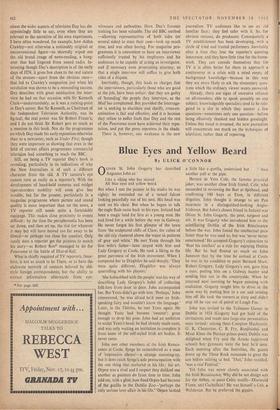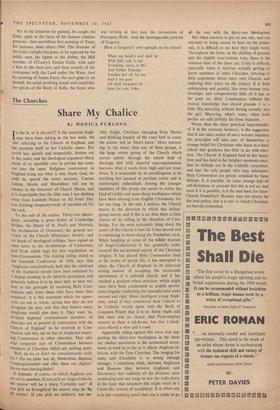Blue Eyes and Yellow Beard
By ULICK O'CONNOR OLIVER St. John Gogarty has described Augustus John as Like a viking who has steered
All blue eyes and yellow beard.
But when I met the painter in his studio he was eighty; he reminded me of a tamed falcon looking peacefully out of his nest. His head was sunk on his chest. But when he began to talk the eagle flash came back to his eyes. Ireland had been a magic land for him as a young man. He had lived for a while before the war in Galway. He never forgot his first glimpse of the town from 'the sculptured cliffs of Clare; the cubes of the old city clustered above the water in patterns of grey and white.' He met Yeats through his first wife's father—later stayed with him and Lady Gregory at Coole. He took a liking to the great patroness of the Irish movement. When I compared her to Diaghilev he said sharply, 'They were quite different, Diaghilev was always quarrelling with his players.'
'She hobnobbed with the people' was his way of describing Lady Gregory's habit of collecting folk-lore from door to door. John accompanied her. But Yeats didn't go with him. 'Perhaps,' John commented, 'he was afraid he'd meet an Irish- speaking fairy and wouldn't know the language.' Later, in the Thirties, he met Yeats again. He thought Yeats had become `sweeter'; great enough to drop his pose. John had an ambition to sculpt Yeats's head; he had already made casts, and was only waiting an invitation to complete it from some of the self-styled Irish art bodies. It never came.
John met other members of the Irish Renais- sance at Coole. Synge he remembered as a man of `impressive silence'—a strange summing-up, but it does catch Synge's sole preoccupation with the one thing that mattered in his life: his art. Orpen was a rival and I suspect they disliked one another as painters do from time to time. John told me, with a glint, how fond Orpen had become of the gorilla in the Dublin Zoo—'perhaps the only serious love affair in his life."Orpen looked a little like a. gorilla, undersized but . .' then another pull at the pipe.
Horace de Vere Cole, the famous practical joker, was another close Irish friend; Cole, who succeeded in reviewing the fleet at Spithead, and confirming 100 boys at Eton, in different disguises. John thought it strange to see Pan incarnate in a distinguished-looking Anglo- Irishman. But John's closest friend in Ireland was Oliver St. John Gogarty, the poet, surgeon and wit. It was Gogarty who introduced him to the scintillating Dublin of the Irish Renaissance before the war. John found the intellectual pace faster than he was used to, but was 'never better entertained.' He accepted Gogarty's injunction to 'float his intellect' as a rule for enjoying Dublin life. But he had floated so much on John Jameson that by the time he arrived at Coole he was in no condition to paint Bernard Shaw. Robert Gregory, Lady Gregory's son, gave him a cure, putting him on a Galway hunter and sending him out in the countryside. When he returned next morning he began painting with exaltation. Gogarty taught him to drive in the same way by putting him in a car and sending him off. He took the corners at sixty and didn't stop till he ran out of petrol at Lough Fee.
John was invited to the Tailteann Games in Dublin in 1924 (Gogarty had got hold of the invitations, and made sure large-size personalities were invited: among them Compton Mackenzie, G. K. Chesterton, C. B. Fry, Ranjitsinhji and Mirai Khan the Persian prince-poet). Dublin was delighted when Fry said the Artane (approved school) boy gymnasts were the best he'd seen. Each morning after the festivities, the guests drove up the Three Rock mountain to greet the sun before retiring to bed. 'That,' John recalled, 'was a real Festival.'
Yet John was never closely associated with the Irish Renaissance. Why did he not design sets for the Abbey, or paint Celtic motifs—Diarmuid Fionn, and Cuchullain? He was himself a Celt, a Welshman. But he preferred the gipsies. Yet in the Irishmen he painted, he caught the Celtic spirit in the faces of his famous contem- poraries: that marvellous first painting of Yeats, for instance, done about 1904. The dreamer of the Celtic twilight has gone; to be replaced by the public man, the fighter at the Abbey, the IRB member of O'Leary's Fenian Faith, with only a hint in the slant eyes and faun nostrils of the communer with the Land under the Wave. And his painting of James Joyce, the man gone in on himself, his mind revolving round and round like the spirals of the Book of Kells, the Joyce who was writing at thattime the involutions of Finnegans Wake. And the incomparable portrait of Gogarty. Here is Gogarty's own epitaph on his friend:
When my hawk's soul shall be With little talk in her Trembling about to flee And Father Falconer Touches her off for me And I am gone All shall forgotten be Save for you, John.











































 Previous page
Previous page